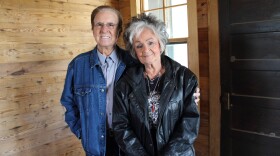As final work is being completed to open Johnny Cash’s boyhood home in Dyess, Arkansas as a museum, his daughter Rosanne Cash came to Little Rock over the weekend for a sold out show and to be honored for her work in helping to restore the small house.
The visit marked the first time Ms. Cash has ever performed in Little Rock and came in advance of the Jan. 14 release of her new CD, The River & The Thread, with songs focused entirely on the southern region of the country. Some are set in Arkansas, inspired she says by her experiences in watching the restoration of the home and community where her late father Johnny Cash was raised.
She performed several songs from the new album during an intimate performance Saturday, alongside husband and collaborator John Leventhal at the Oxford American’s new performance space South on Main. Cash also writes an essay in the Oxford American's annual music issue, which this year focuses on Tennessee and will be released next week.

Earlier in the day Cash visited the Old State House Museum, where she was honored for her work with Arkansas State University and the National Trust for Historic Preservation to help restore her dad’s home.
“I haven’t done any of the hard work; I’ve just shown up and helped them raise some money by performing. The real credit goes to the team who has done the restoration,” Cash said afterward.
She also toured the Old State House Museum, which has several Johnny Cash artifacts, including old family photos, movie posters and one of his suits.
“My dad was always incredibly proud of where he came from and it was always a real part of who he was and his persona in the world was that he was from Arkansas, he was raised on a cotton farm,” Cash said.
“Coming back to that when we started the restoration of his boyhood home and seeing really what that meant, how far he walks from the house to school, how big the land was that they farmed, how hard the life was. It really gave me a whole new level of respect and understanding, even though I thought that I’d understood that, just to see the tangible remnants of that, like these things that they have here, it makes quite an impact. It helps you know who you are if you know who your parents really were.”
Ray and Carrie Cash moved into the home with their children in 1935. Dyess was a planned community, created during the Great Depression as part of President Franklin Roosevelt’s New Deal. The Cash family was among 500 who were selected to be a part of the community, with each getting a home and 40 acres to farm.

“The Cash family were desperately poor and this saved their lives,” Rosanne Cash said in an interview with KUAR. Their move into the home inspired her new song "The Sunken Lands."
“My father was three years old when they moved into their new cottage and he said his first memory was of five cans of paint in the front room of the house, his brand new home. And I put that imagery in the song and it’s really about my grandmother Carrie Cash and how she raised seven children, picked cotton and in the song she sails away from all of that, but in real life she didn’t.”
The Cash family eventually sold the house in the 1950s and it changed hands a few times over the decades until Arkansas State University, realizing the cultural importance of Johnny Cash, recently bought the house and recruited family members to help.
But the home had deteriorated with age, in part because of the region’s gumbo soil, which shifts and caused the foundation to become unlevel. Rosanne Cash references gumbo soil on the new CD in her song “A Feather’s Not A Bird.”
As ASU began the project, officials brought in Cash’s family members who have been instrumental in efforts to make this restoration as authentic as possible.

“I was really thrilled to be involved and really moved by what they’ve done,” Rosanne Cash said. “Their historical accuracy is just beyond belief, to find just a chip of paint and then send it to the lab to find exactly what the color was. And they consulted my aunt Joanne a lot, who lived there, who grew up there, about what the furniture, what the linoleum looked like. So the restoration of the house is complete and it’s really amazing.”
The Cash home is only part of the overall restoration, which also includes the town’s administration building to serve as a visitor’s center.
A soft opening of the museum is planned for next April, says Dr. Ruth Hawkins, director of ASU’s Arkansas Heritage Sites program, who has been overseeing the project. The Cash family and those involved will mark the opening on April 25, while it opens to the public the following day.
“It will be limited hours for a while because we will be staffing it with graduate assistants, but then we’re looking for a grand opening and being fully open in the fall of 2014,” Hawkins said.
“When we open in April, people who come to visit will go to the administration building and they will tour those exhibits first, then they will be shuttled out to the house and when they walk in, it’ll be fully furnished just like when the Cash family had walked out the door.”






